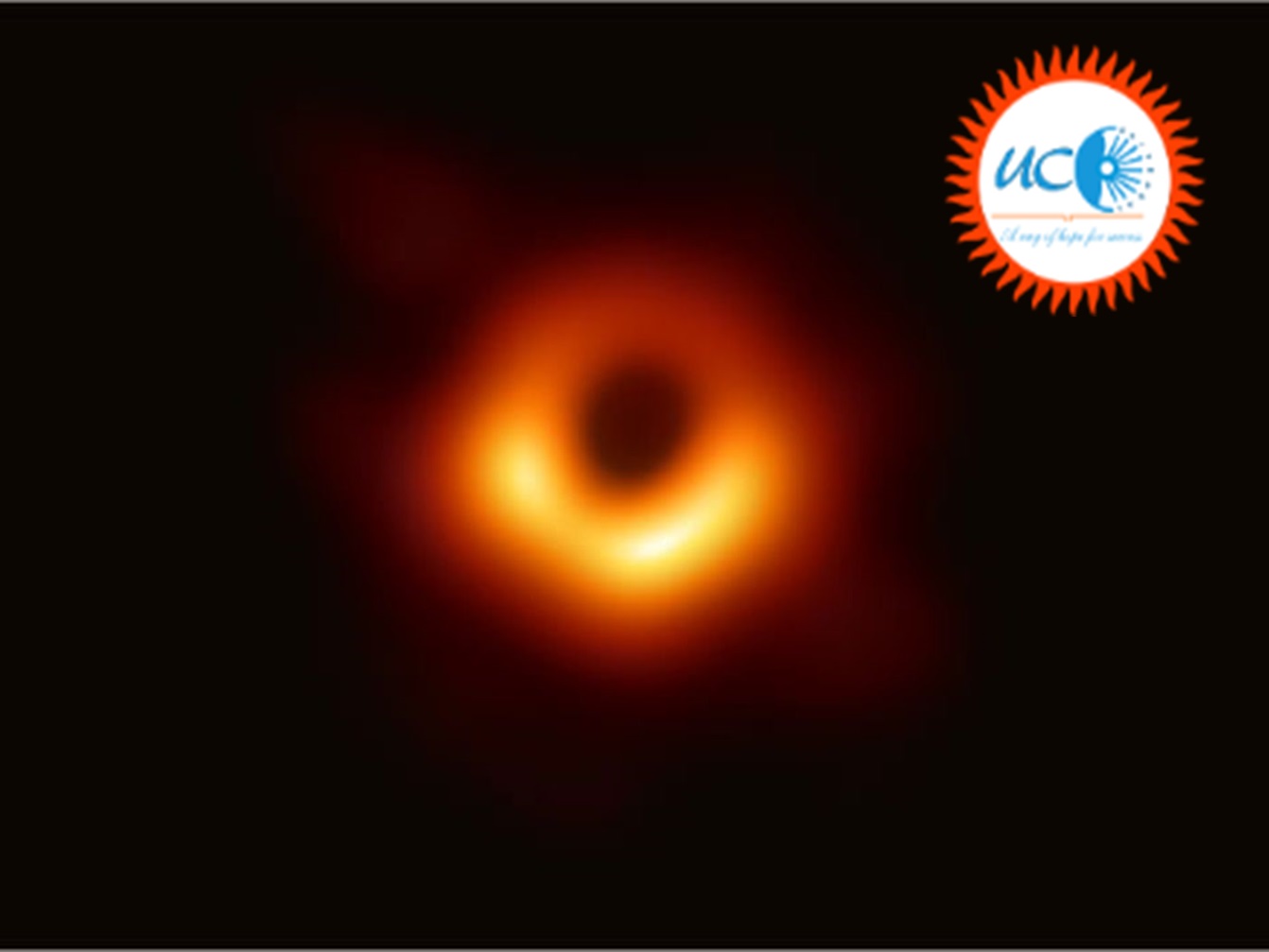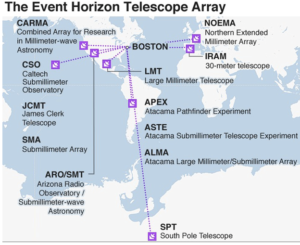Event Horizon reveals true colours of Sagittarius A* (SgrA*)
Why in News?
Recently, scientists from the Event Horizon Telescope (EHT) facility, at press conferences held simultaneously at several centres around the world on Thursday, revealed the first image of the black hole at the centre of the Milky Way.
- The image of Sagittarius A* (SgrA*) gave further support to the idea that the compact object at the centre of our galaxy is indeed a black hole, strengthening Einstein’s general theory of relativity.
Background:
- In 2019, the Event Horizon Telescope facility, a collaboration of over 300 researchers, made history by releasing the first-ever image of a black hole, M87* — the black hole at the centre of Messier 87, a supergiant elliptic galaxy.
- The ring-shaped image of SgrA*, which looked a lot similar to the one of M87*, occupied 52 microarcseconds in the field of view, which is as big a span of our view as a doughnut on the moon.
- The whole exercise was possible because of the enormous power of the Event Horizon Telescope, an ensemble of several telescopes around the world, which together were like a giant eye on the earth with a sight that is 3 million times sharper than the human eye.
What is a Black Hole?
- Black hole refers to the remains of a supergiant star that has collapsed into itself.
- It is so dense and has a gravitational field so intense, that light itself cannot escape from it.
- Formation of Black Hole: When stars much more massive than the Sun reach the end of their lives, they collapse under their own gravity, and the product of this collapse, most astronomers believe is a black hole.
- Parts of Black Hole: A black hole has two parts:
- Singularity: At the core of a black hole is a singularity. It is a point that is infinitely dense, as all the remnant mass of the star is compressed into this point.
- Event horizon: It is an imaginary surface surrounding the singularity, and the gravity of the object is such that once anything enters this surface, it is trapped forever. Not even light can escape the pull of the singularity once it crosses the event horizon.
Special Theory of Relativity
Einstein first introduced this term in the year 1905. It is a theorem that deals with the structure of space-time. Einstein explained this theory based on two postulates –
- The laws of physics are the same for all, irrespective of the observer’s velocity.
- The speed of light is always constant regardless of the motion of the light source or the motion of the observer.
This is the theory which laid the foundation of time travel. According to Einstein, the rate at which time tics decreases with the increase of the person’s velocity. But this is hard to notice as the decrease in time is relatively very low compared to the increase in time. So, it can be assumed that if you can equal the velocity of light, you will be in a situation where time is still. This phenomenon is called Time Dilation. There are other surprising consequences of this theory, such as –
- Relativity of simultaneity – two actions, simultaneous for one person, may not be simultaneous for another person in relative motion.
- Length Shrinking: Objects are measured and appear shorter in the direction they are moving with respect to the observer.
- Mass – Energy Equivalence: Study of relativity led to one of the greatest inventions, i.e., E = mc2 where E is Energy, m stands for mass and c for the velocity of light. Many scientists observed that the object’s mass increases with the velocity but never knew how to calculate it. This equation is the answer to their problem, which explains that the increased relativistic weight of the object is equal to the kinetic energy divided by the square of the speed of light.
General Theory of Relativity
General Relativity theory, developed by Einstein in 1907-1915, states that being at rest in the gravitational field and accelerating are identical physically. For example, an observer can see the ball fall the same way on the rocket and on Earth. This is due to the rocket’s acceleration, which equals 9.8 m/s2. This theory relates to Newton’s gravitational theory and special relativity.
Sagittarius A*:
- Sagittarius A*, often abbreviated to Sgr A* and pronounced “Sagittarius A star”, is a supermassive black hole located at the center of our spiral galaxy, the Milky Way.
- Sagittarius A* is 27,000 light years from us.
- The Milky Way’s central black hole lies at a distance of 26,673 ± 42 light years from Earth in the direction of Sagittarius constellation, near the border with Scorpius.
- Imaging Sagittarius A* (SgrA*) was much more difficult than imaging M87*:
- first, SgrA* is only one-thousandth the size of M87*;
- second, the line of sight is obscured by a lot of matter; and as SgrA* is much smaller than M87*,
- the gas swirling around it takes only minutes to complete an orbit around SgrA* as opposed to taking weeks to go around M87*.
- The last gives a variability that makes it difficult to image.
- A clear imaging requires long exposure of eight to 10 hours, where ideally the object should not change much.
What is Event Horizon Telescope?
- The Event Horizon Telescope (EHT) is a planet-scale array of eight ground-based radio telescopes forged through international collaboration.
- The EHT links telescopes around the globe to form an Earth-sized virtual telescope with unprecedented sensitivity and resolution.
EHT array: Following Telescopes are part of it –
- Atacama Large Millimeter Array
- Atacama Pathfinder Experiment
- Heinrich Hertz Submillimeter Telescope
- IRAM 30m telescope
- James Clerk Maxwell Telescope
- Large Millimeter Telescope
- South Pole Telescope
- Sub-millimeter Array
Objective: The EHT was designed to capture images of a black hole. It offers scientists a new way to study the most extreme objects in the Universe predicted by Einstein’s general relativity during the centennial year of the historic experiment that first confirmed the theory.
Bodies involved: Thirteen partner institutions worked together to create the EHT. Key funding was provided by the US National Science Foundation (NSF), the EU’s European Research Council (ERC), and funding agencies in East Asia.
Technique Used: The EHT observations use a technique called very-long-baseline interferometry (VLBI).
Way forward:
The collaboration hopes to improve their capacity so that they can not only image black holes but construct movies and study the magnetic field further.







